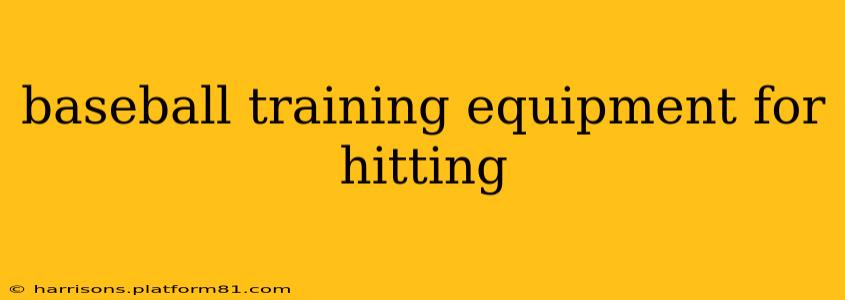Becoming a better hitter in baseball requires dedication, practice, and the right equipment. This guide explores the essential and advanced training tools that can significantly improve your batting skills, from foundational drills to specialized techniques. We'll cover everything from the basics to more advanced tools to help you find the perfect equipment to elevate your game.
What are the Basic Pieces of Baseball Hitting Training Equipment?
The foundation of any successful hitting program starts with a few essential pieces of equipment. These are generally affordable and readily available:
-
Baseball Bat: This seems obvious, but choosing the right bat is crucial. Beginners should focus on bats with lighter weight and a larger barrel for better control and a larger sweet spot. As you progress, you might explore different weights and barrel sizes to find what best suits your swing.
-
Baseball: Having a consistent supply of quality baseballs is paramount. Worn or damaged balls can affect your training by altering the ball's flight and feel. A bucket of new or gently used baseballs is a must-have.
-
Tee: A batting tee allows for consistent, controlled practice. It helps develop proper swing mechanics and timing without the added complexity of pitching. Choose a tee that is adjustable in height to cater to different stances and drills.
-
Hitting Net: A hitting net provides a safe and convenient space to practice your swing. It prevents balls from flying off into unintended areas, keeping your practice sessions focused and safe. Consider nets with varied sizes and durability depending on your needs and space constraints.
-
Gloves: While not directly involved in hitting, wearing a batting glove improves grip and feel of the bat, leading to better control and consistency.
What are Some Advanced Baseball Hitting Training Aids?
Once you've mastered the basics, incorporating advanced training aids can significantly refine your hitting technique:
Weighted Bats:
These bats are heavier than standard bats and are designed to build strength, improve swing speed, and enhance bat control. Using weighted bats regularly can significantly improve your power and bat speed when you switch back to a standard bat.
Soft Toss:
Soft toss is a fundamental drill where a teammate or coach gently tosses the ball to the hitter. This practice enhances hand-eye coordination, improves bat control, and aids in developing a consistent swing path. No special equipment is needed beyond a baseball and a partner.
Pitching Machine:
A pitching machine provides consistent pitches at adjustable speeds, allowing hitters to work on specific aspects of their swing against various pitch types and velocities. This helps in improving reaction time, pitch recognition, and overall batting performance under game-like conditions.
Swing Trainer:
Swing trainers come in various designs, each focusing on specific aspects of the swing. These devices often incorporate sensors and feedback mechanisms to help identify and correct flaws in technique. Examples include devices that measure bat speed, swing path, and impact point.
What About Technology and Baseball Hitting Equipment?
Modern technology has revolutionized baseball training. Several gadgets and software are now available to help players analyze their swing and identify areas for improvement.
Launch Monitors:
Launch monitors measure various aspects of a hitter's swing, such as exit velocity, launch angle, and distance. This data provides valuable insights into performance and allows players to track progress over time.
Swing Analysis Software:
Several software applications use video analysis to track swing mechanics and provide detailed feedback on technique. These programs can highlight flaws in your swing and suggest ways to improve.
How Can I Choose the Right Hitting Training Equipment?
Selecting the appropriate hitting training equipment depends on several factors, including your skill level, budget, and training goals.
-
Skill Level: Beginners should start with fundamental equipment like a tee, batting net, and a lightweight bat. As your skills improve, you can progressively incorporate more advanced tools.
-
Budget: Equipment costs can vary significantly. Prioritize essential items first and gradually add more advanced tools as your budget allows.
-
Training Goals: Define your specific goals before investing in equipment. If you want to improve power, a weighted bat might be beneficial. If you need better hand-eye coordination, soft toss is a great option.
By carefully considering these factors and leveraging the resources available, you can build an effective and tailored hitting training program to help you reach your baseball goals. Remember that consistent practice and the right tools are key to improvement.
